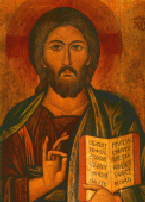|
RGH1010
syllabus (PDF) for 2005/6 (available Sept. 2005). The materials contained
on this web-site complement the full syllabus.
|
|
|
Description:
From the sub-apostolic age to the "Triumph of Orthodoxy"
in the East and the Carolingian revival and Treaty of Verdun in
the West. Geographical expansion of the church; the relation of
Christian faith to cultural settings and other religions; the development
of doctrinal and ethical positions; forms of Christian life and
worship; the rise of Islam. Lectures, tutorials, Short papers, essay.
Note: Please
consult the syllabus given to you in class for course requirements
& due dates. And, check back weekly for updates to the on-line
Lecture & Tutorial readings.
Course Texts &
Readings:
1. New for 2005: Gonzalez, J. The Story of Christianity. Vol. 1. Harper & Row, 1984. (Any edition is acceptable. Available at Crux Bookstore, behind Wycliffe College).
2. The on-line readings listed below [Uploaded weekly].
3. Some photocopies [the small cost will be calculated towards the
end of the course].
On-line reference
materials:
1. General Assignment & Research
information.
2. Time-Line for Selected
Early Church Authors (PDF)
2. Researching Early Christian
History & Authors (PDF)
4. Nicene-Constantinopolitan Creed
(A Comparison) (PDF)
1. Introduction:
-Methodology & Who Were the Early Christians?
- definition of terms; sources; background information; historiography.
2. The Apostolic
Church :
- Mission, Conversion, Church & State
- the spread of Gospel; Judaism; paganism; Didache, Clement of Rome,
Hermas, Ignatius.
Lecture & Tutorial Readings
Optional:
For some maps and additional information, consult: "From
Jesus to Christ."
3. Apologists, Martyrs &
Systems of Cosmic Redemption
- State Persecution of Christians: Polycarp, Justin, Athenagoras,
Papias, Perpetua & Felicity; Irenaeus & Gnosticism; Montanism.
Lecture & Tutorial Readings
Archeology:
Some images of the catacombs
in Rome.
Optional: A brief synopsis of Elaine Pagel's, The
Gnostic Gospels.
4. Early Western
Authors & North African Christianity
- Tertullian, Hippolytus, Cyprian, Sabellianism.
Lecture & Tutorial Readings
5. The Early School
at Alexandria
- Pantaneus, Clement of Alexandria, Origen, Ps-Dionysius.
Lecture & Tutorial Readings
AND Review this MAP
of the growth of Christianity (c.100-300AD).
Maps: Other
maps at Ancient World Mapping
Centre [see the section of free maps].
Optional: A resource for other on-line
writings in early Christianity.
6. Early Christologies
& Councils (Nicea I - 325AD)
- Athanasius, Arius, Eusebius, Donatism, Church-State.
Lecture & Tutorial Readings
The Nicene-Constantinopolitan
Creed. I'll hand out a copy in class, but you should review
this prior to class.
Archeology: Triumphal
Arch of Constantine, constructed to honour his "triumph"
in becoming the Roman emperor in the West.
Archeology: Ancient world map of Nicea.
Click on the map of Turkey, then click on Nicea. Read the opening
narrative.
7. Cappadocians, Spirit-Fighters &
Constantinople 1 (381)
- Macrina the Younger, Basil the Great, Gregory Nazianzus, Gregory
of Nyssa.
Lecture & Tutorial Readings
8. Syriac Christianity
& the Roots of Monasticism
- Bardaisan, Aphrahat, Ephraem, Pachomius, Anthony, Basil, Evagrius,
Syncletica, Egeria -
Lecture & Tutorial Readings
Archeology: Read the synopsis of the
Church
of the Holy Sepulchre (Anastasis) [built on the site that
Egeria describes in the tutorial readings]. Click on the link
to "Helena."
9. East & West
in the Fourth Century
- Ambrose, Augustine, Hilary of Poitiers, Jerome, Vincent of Lérins,
John Chrysostom -
Lecture & Tutorial Readings
Manuscripts:
Read about the Latin
Vulgate and Jerome's contributions.
Manuscripts:
For contextual information relating to Jerome's work on the Scriptures,
read the commentary on the Codex
Sinaiticus, a mid-fourth century manuscript of the New Testament.
10. The Theotokos
& Ephesus (431), Chalcedon & Classical Christological Doctrine
- Theodore of Mopseustia, Cyril of Alexandria, Nestorius, Leo,
Eutyches, Assyrian & Oriental Orthodox Churches..
Lecture & Tutorial Readings
Maps: Familiarize yourself with this modern map of the
Middle
East, and compare it to the historical map you received with
the course syllabus. Look also at this satellite
map and read the commentary.
*** It is very important that you get a
sense of modern and ancient geography---it will help you contextualize
the geographical spread of Christianity in the East. This will
also be useful for next week when we describe the rise of Islam.
Archeology: Take a look at this ancient
world map of Ephesus.
Click on the map of Turkey, then click on Ephesus. A window will
pop up, and on the bottom left-hand corner will appear a legend
map. Click on the area to the left of "Church" and a
virtual tour of the ruins will begin. Clicking on the coloured
dots will load a panoramic video. You can then "move around"
in the video to see what is around you (you can also zoom in and
out of each shot). See if you can find what looks like a baptismal
font? an altar/sanctuary?
[Hint: You navigate in the video by placing
the mouse cursor over the video window, and hold down the left
mouse key to "drag" you left or right. You need a high-speed
internet connection for this].
11. Christological Disputes Continue
& Invasions in the East & the West (6th-7th centuries)
- monotheletism; invasions in the West; Islam in the East; Gregory
the Great; Justinian I.
Lecture & Tutorial Readings
Architecture & Manuscripts: See
the links within the tutorial readings.
12. Iconoclastic
Crisis in the East & a New Emperor in the West (to 843AD)
- Charlemagne; iconoclasm & Nicea II; John Damascus; Theodore
the Studite; Theodore Abu Qurrah; China; early missions to the Slavs.
Conclusion/summary of course.
Lecture & Tutorial Readings
Archeology: A description and images
of the "Nestorian
Stone" in China (c.781).
Review: "Comparison
Table of Iconoclast & Iconophile Thought" (Print
and bring it to class).
Icon: The image described in the legend
of Abgar (above) is called the Acheiropoietos (literally, "not-made-with-human-hands").
Here is an example of this icon.
Optional Icons:
Some early images, from the second
century up to the 8th century. [I will comment on these in class
in a slide-show presentation].
|
